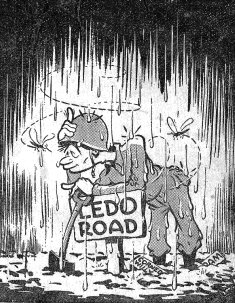

|

Stories of the Stilwell Road as reported in CBI ROUNDUP Newspaper of the China-Burma-India Theater of World War II |
 Lt. Gen. Dan I. Sultan, India-Burma Theater Commander, speaking at the ceremonies which marked the first convoy to
China, at Wanting. His speech was translated into Chinese by Gen. Sun Li-jen, commander of the Chinese First Army,
who stands at the right of Gen. Sultan. Behind and to the left of Gen. Sultan are Gens. Pick, Davidson and Chennault.
Marshal Wei Li-Huang, commander of the Chinese Expeditionary Force, is behind and immediately to the right of
Gen. Sultan.
Lt. Gen. Dan I. Sultan, India-Burma Theater Commander, speaking at the ceremonies which marked the first convoy to
China, at Wanting. His speech was translated into Chinese by Gen. Sun Li-jen, commander of the Chinese First Army,
who stands at the right of Gen. Sultan. Behind and to the left of Gen. Sultan are Gens. Pick, Davidson and Chennault.
Marshal Wei Li-Huang, commander of the Chinese Expeditionary Force, is behind and immediately to the right of
Gen. Sultan.
|
 Brig. Gen. Lewis A. Pick, who led the first China convoy, speaks at the ceremonies which marked the arrival of the
convoy at Kunming. His speech was translated by Col. Yee Fu-de, public relations officer of the Chinese First Army
(right).
Brig. Gen. Lewis A. Pick, who led the first China convoy, speaks at the ceremonies which marked the arrival of the
convoy at Kunming. His speech was translated by Col. Yee Fu-de, public relations officer of the Chinese First Army
(right).
|
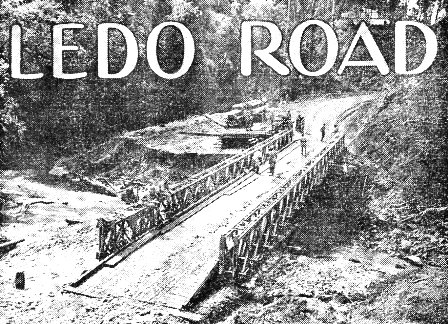 A newly-constructed Bailey Bridge - latest in military stream crossing equipment - replaces a temporary wooden
structure over a stream on the Ledo Road in Burma.
A newly-constructed Bailey Bridge - latest in military stream crossing equipment - replaces a temporary wooden
structure over a stream on the Ledo Road in Burma.
|

|
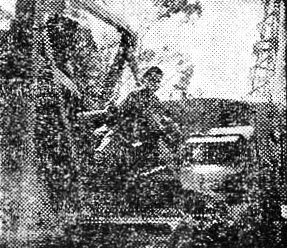 A G.I. operates a huge crane in swinging a span of steel bridge across a jungle stream.
A G.I. operates a huge crane in swinging a span of steel bridge across a jungle stream.
|
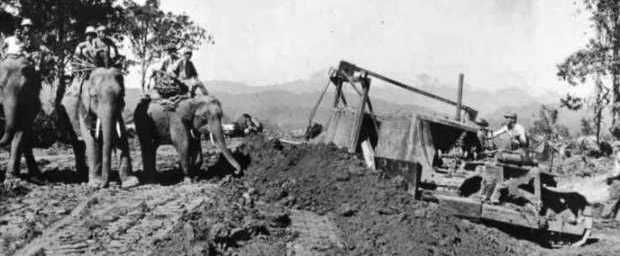
|
|
"It is now generally called the Ledo-Burma Road. But there is little doubt that far more appropriately it could be named after the man whose almost single-handed pertinacity is responsible for this spectacular achievement. If history, in an off guard moment, should decide to do justice to one individual this overland lifeline to China should be known as "Stilwell Road." |
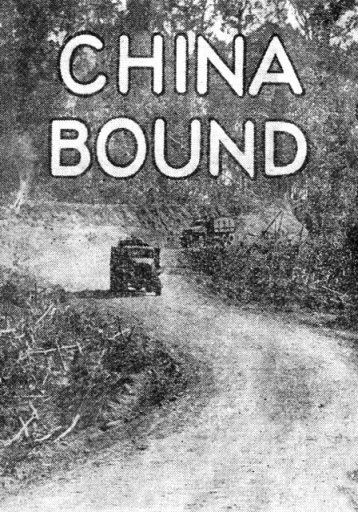 Two trucks roar along one of the winding sections of the supply artery to China, soon to be opened.
Two trucks roar along one of the winding sections of the supply artery to China, soon to be opened.
|

|
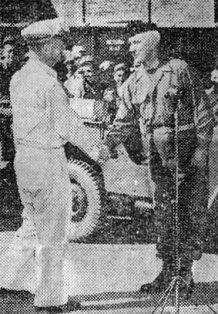 Lt. Gen. Dan I. Sultan is greeted by Brig. Gen. Lewis A. Pick at the head of the first convoy to China at Mile
Point 0.00.
Lt. Gen. Dan I. Sultan is greeted by Brig. Gen. Lewis A. Pick at the head of the first convoy to China at Mile
Point 0.00.
|
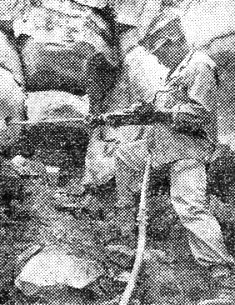 A Negro G.I. - one of the many whose heroic, unheralded efforts made The Road possible.
A Negro G.I. - one of the many whose heroic, unheralded efforts made The Road possible.
|
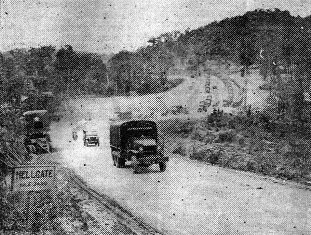 Trucks of the convoy pass Hellgate and start up the grade to Pangsau Pass. There are seven and one half miles of
steep grades and sharp curves to the summit of incredibly beautiful Pangsau Pass, which is the India-Burma border.
Trucks of the convoy pass Hellgate and start up the grade to Pangsau Pass. There are seven and one half miles of
steep grades and sharp curves to the summit of incredibly beautiful Pangsau Pass, which is the India-Burma border.
|
|
INITIAL CHINA CONVOY ARRIVES IN KUNMING |
|
LOOK OUT FOR CURVES 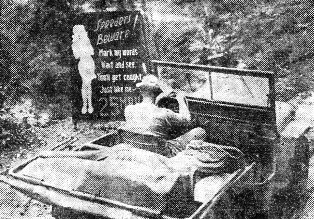 Miffed by the San Francisco Chronicle's weird article that Ledo Road Engineers erected interesting road
signs in Italy, of all places, the hairy ears sent along the above photograph to prove that their handiwork was fashioned
along "Pick's Pike."
(The sign reads: Speeder's Beware! Mark my words, Wait and see, You'll get caught, Just like me! 25 MPH.)
Miffed by the San Francisco Chronicle's weird article that Ledo Road Engineers erected interesting road
signs in Italy, of all places, the hairy ears sent along the above photograph to prove that their handiwork was fashioned
along "Pick's Pike."
(The sign reads: Speeder's Beware! Mark my words, Wait and see, You'll get caught, Just like me! 25 MPH.)
|

|